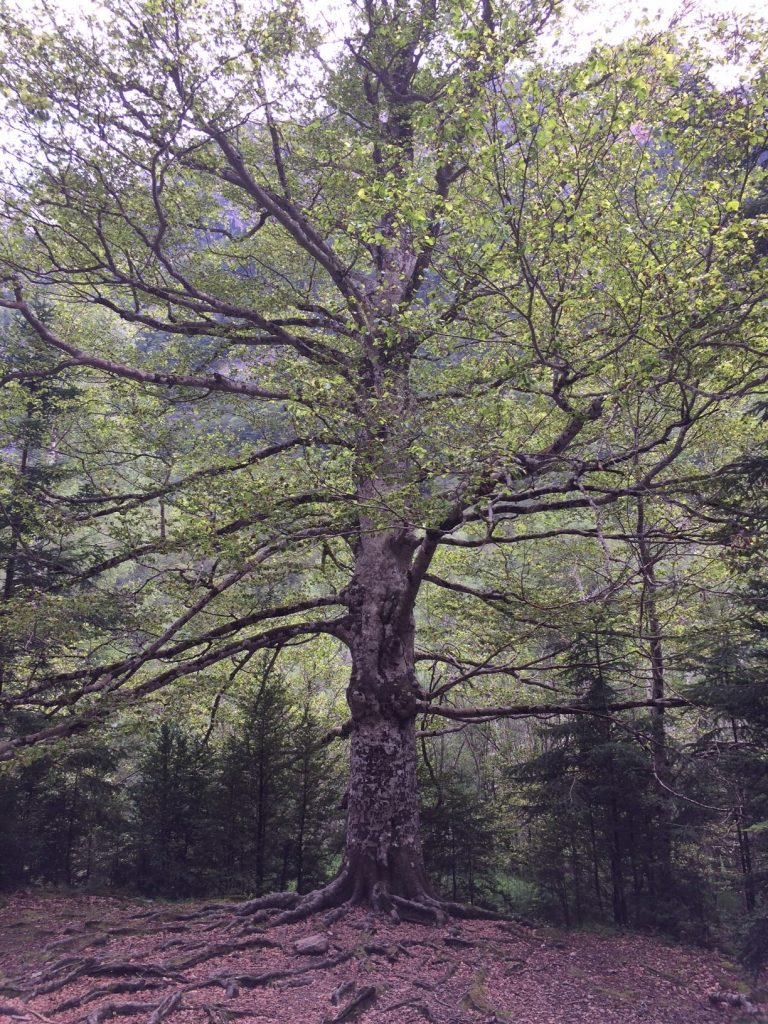I recently returned from a visit to the Pyrenees – a mountain range that separates France and Spain. I spent some time hiking through Spanish forests where the European beech (Fagus sylvatica) is a dominant tree species.
When compared to Pennsylvania, much of Spain is dry. Beech forests only occur at relatively high elevations – 2,000-5,000 feet.

European beech is considered more tolerant of the fungi that cause beech bark disease (BBD) than the American beech (Fagus grandifolia), and more resistant to the scale insect that leads to infection of the fungus.
However, it is not more huggable. The European beech, although readily identifiable as being a close cousin to the American beech, still looks different.
While the chestnut is the Ent of American forests, the European beech would win first prize in a Treebeard look alike contest. Their bark is scarred by the fungal infections they are constantly fighting. Covered in moss, wisdom oozes from these trees.

The European beech is a warrior, experienced in battle sporting scars both within and without. Oh the stories they could share with their American comrades. Perhaps they inspired this quote by William Shakespeare:
“Though I look old, yet I am strong and lusty; for in my youth I never did apply hot and rebellious liquors in my blood; and did not, with unbashful forehead, woo the means of weakness and debility: therefore my age is as a lusty winter, frosty but kindly.”

In these beech stands I found evidence of tremendous mast crops. In some place, the forest floor was literally covered 1-2 inches deep in beechnut shells. A wildlife food bonanza! I caught myself looking for bear claw marks on tree trunks – until I reminded myself there were no black bears on that side of the Atlantic.

However, it appears changes are afoot for the European beech.
Neither the American nor European species are especially tolerant of wet soil conditions. In Europe (and recently in the U.S.), several species of Phytophthora fungi are causing mortality in beech. These fungi kill the roots and cause rot around the base of the tree.
Climate change is expected to increase rainfall which is expected to increase infections of this fungus in European beech as well. Warmer winters, a shift in rainfall from summer to winter, and heavier rain events translate into an increase in Phytophthora-caused mortality.
To add insult to injury (or more injury to injury), these infections lead to increased infections of BBD! So even when the scale insect is absent, the Phytophthora infections provide an avenue for the BBD fungi to invade the tree.
 We are just beginning to understand and experience the effects of climate change on our world. Episodes of beech mortality will have tremendous impacts on the forested ecosystems of Europe. The loss of beech will disrupt plant and animal communities. And as the forests lose species they lose resiliency to further disturbances due to climate change or invasive plants and animals. A potentially vicious cycle.
We are just beginning to understand and experience the effects of climate change on our world. Episodes of beech mortality will have tremendous impacts on the forested ecosystems of Europe. The loss of beech will disrupt plant and animal communities. And as the forests lose species they lose resiliency to further disturbances due to climate change or invasive plants and animals. A potentially vicious cycle.
Unfortunately, the future is likely fraught with peril for this grand tree, an Ent of the Pyrenean forest.
-Duane Diefenbach
Additional information:
If you would like to receive email alerts of new blog posts, subscribe here.
And Follow us on Twitter @WTDresearch
